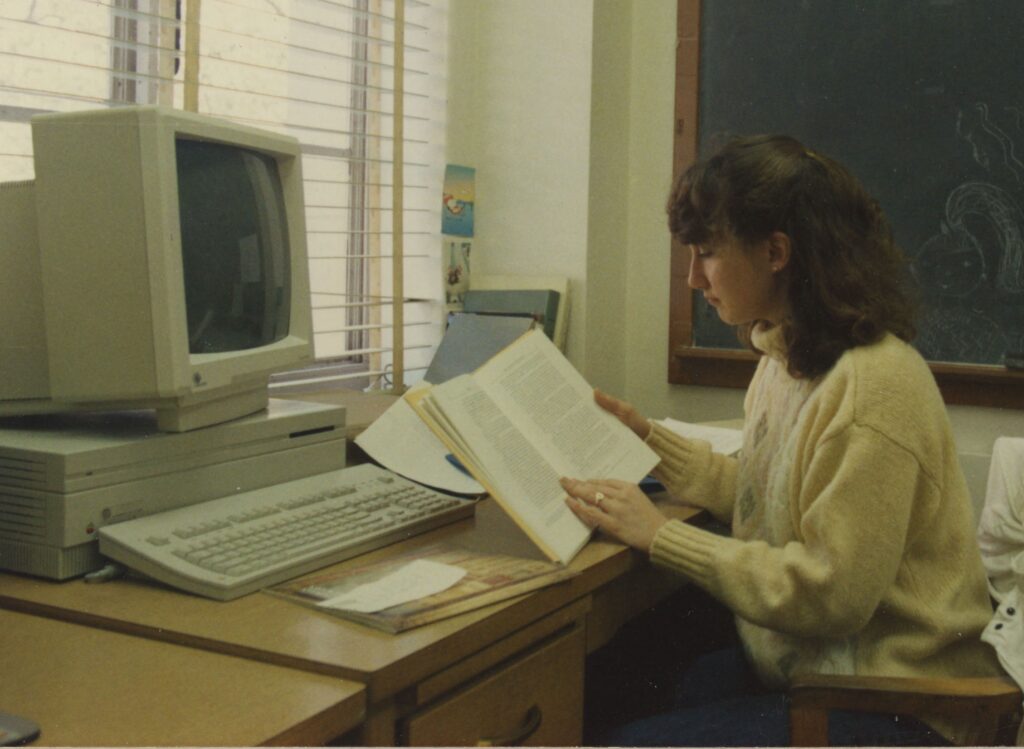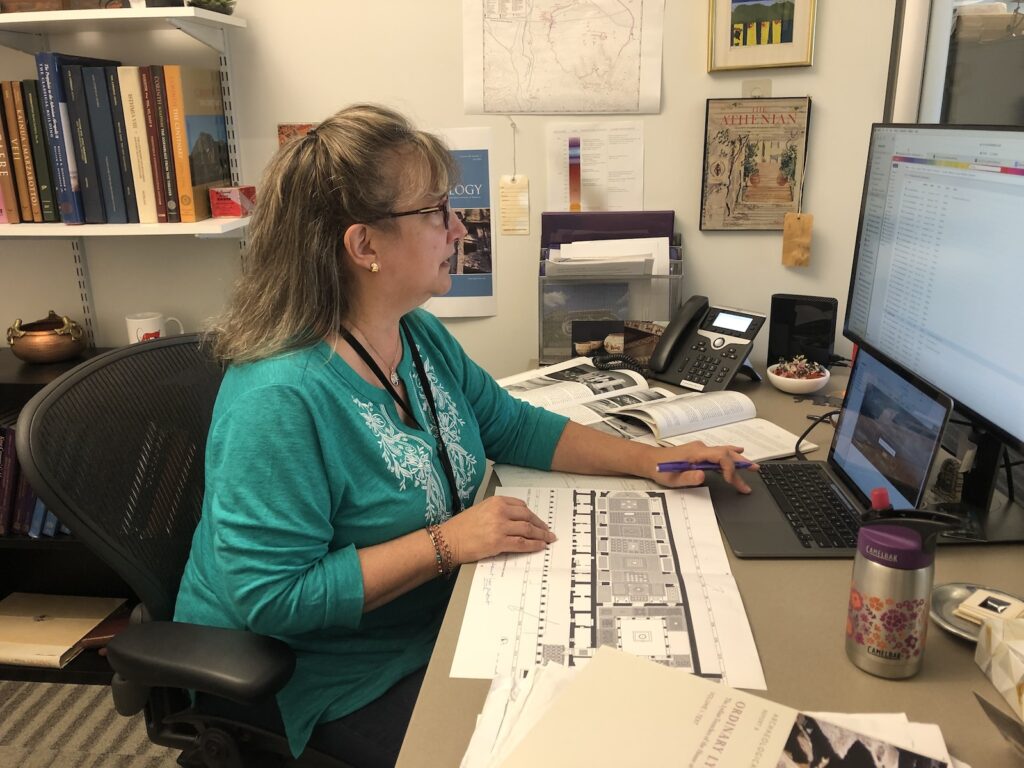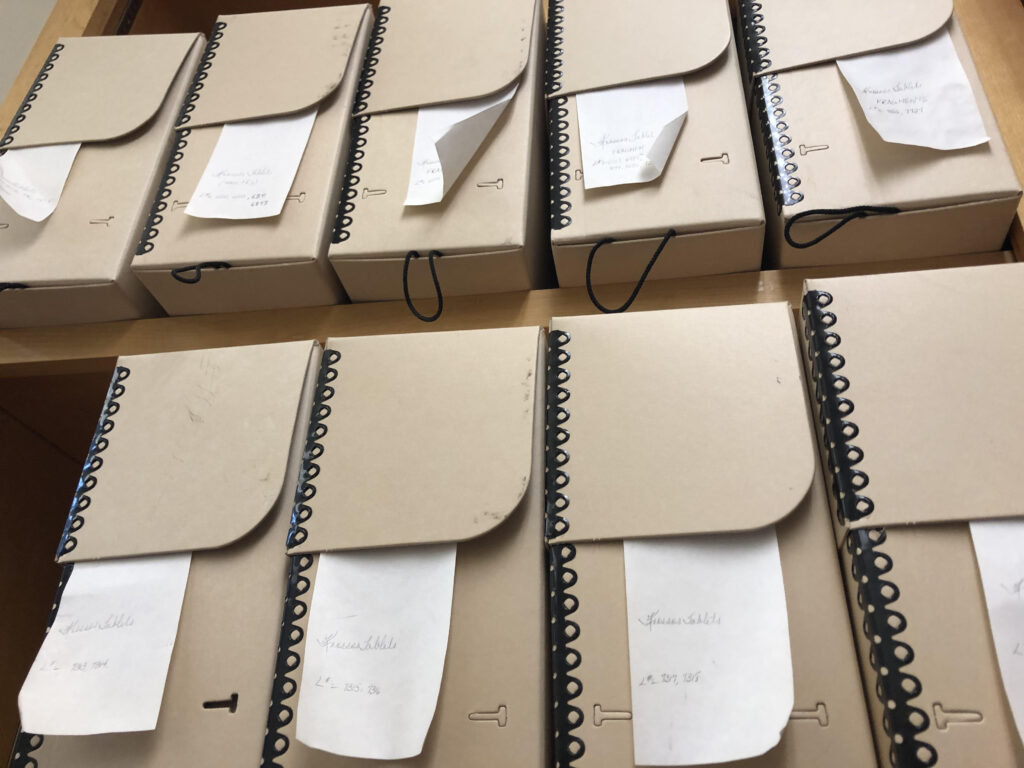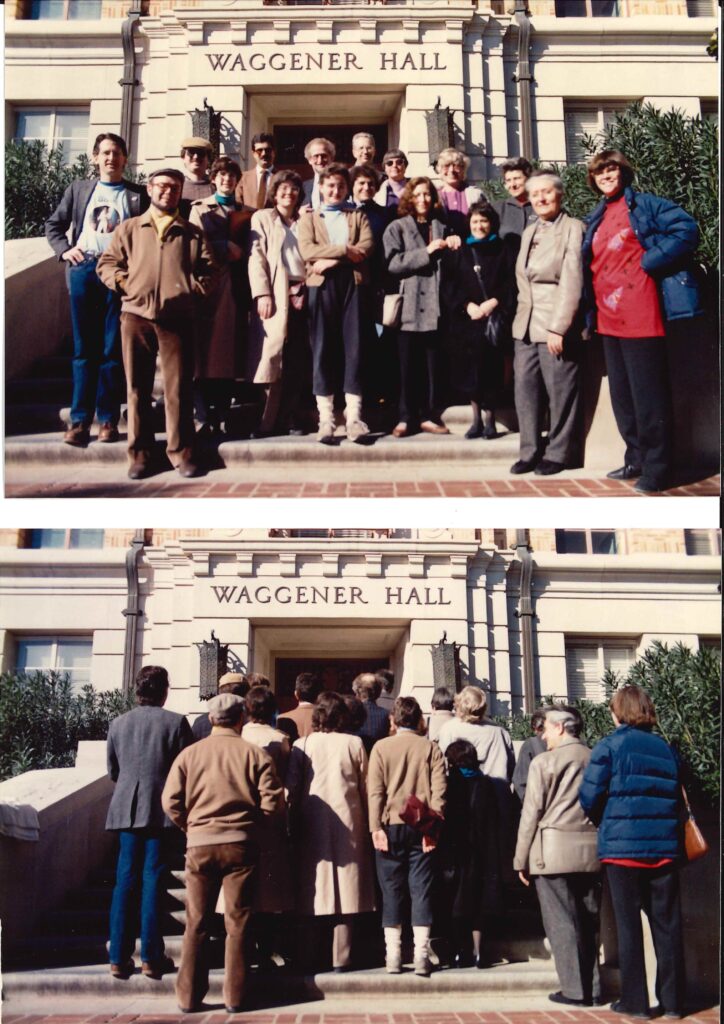by Kerri Cox Sullivan
Publications Research Editor
Archaeological Exploration of Sardis
Harvard Art Museums
On a short trip to Austin in July 2024 I made a brief visit to the WAG 14 suite, the long-time home of the Program in Aegean Scripts and Prehistory—and the place where I began my own academic career as a first-year graduate student/teaching assistant in September 1987.

Seeing so much that was familiar (indeed identical to what I remember) was bittersweet, as the complicated process of organizing and moving all the materials to their new home at the University of Cincinnati was already well underway. It was strange to think that this collection, whose early days I had witnessed, was leaving Texas with director Tom Palaima’s retirement (TGP being “retired” is inconceivable to me, but that is a different story).
This return to PASP reminded me of how much of my own career has been influenced by what I did and learned while working there, and how many of those skills and experiences have remained valuable to me both in my current role as Publications Research Editor for the Harvard Art Museums’ Archaeological Exploration of Sardis, and during the years in between, at the ASCSA and other academic presses.

I arrived at UT Austin in September 1987 having been an undergraduate double major—Greco-Roman languages and culture, and historical linguistics—and intending to specialize in archaeology. I knew that I wanted to embark on a career in publishing at some point in the future. Part of what had inspired me to go to grad school in classics rather than linguistics was a 1985 AJA article by Palaima and Wright. I was fortunate then to be assigned as one of three new PASP assistants that fall, only the second class of students to work in the fledgling program. Bruce Laforse, Philip Freeman, and I thus joined Jean Alvares and Yuri Weydling as Tom’s assistants. I remember watching in amazement as Jean used a font-modification program to create a special set of under-dotted letters for transcriptions of Linear B to be used in our early word-processing programs. Aware of my interest in publishing, Tom generously entrusted me with the proofreading of his Scribes of Pylos as my initial assignment in PASP.1 In those very early days we were just starting to receive the first collections of offprints (Frank Stubbings) and microfilm (the Evans Knossos notebooks), so the offices were still fairly empty.2
Our big project that first autumn, and for several semesters afterward, was the identification and filing of thousands of black-and-white photographs of the Linear B tablets from Pylos and Knossos—a core component of the PASP collections till this day. The photos had arrived from Louis Godart at the Istituto per gli Studi Micenei ed Egeo-Anatolici in Rome with handwritten negative numbers on their backs but bearing no other identifying information. Armed with a copy of the Linear B syllabary, a reverse glossary of Linear B terms, and the various Linear B corpora then available, Bruce, Philip, and I spent hours trying to read the signs on each photo, look up the terms to see what tablets they appeared on, and then by a kind of process of elimination identify the tablet and its number. Of course, the longer texts were straightforward, but some of the fragments presented real challenges! We wore archival gloves for this work, put the photos in their mylar sleeves, and then placed each photo in an acid-free folder and each tablet series into its own archival box. These accoutrements are commonplace in archival practices today, but back then this was all very new to us. I think of those days in PASP every time I put on my gloves to search through Sardis’s hundreds of thousands of black-and-white negatives for items that have to be scanned.
This long-term project gave Bruce, Philip, and me the rare opportunity to gain a deep and lasting familiarity with the Linear B syllabary. This was especially useful that spring of 1988, when Tom taught a course in Aegean scripts. Bruce, Philip, and I were joined in that seminar by others who would become PASPians, including Bill Hutton, Nicolle Hirschfeld, and the late, great Fred Schwink. We all gave lengthy seminar presentations (mine being on Pylos Tn 316), and several of those research papers turned into master’s theses. I remember these as joyful class meetings with lively exchanges of ideas and much collaboration among the students both in class and then in the Classics library on the weekends. This was one of my favorite seminars from my time in graduate school.
During the summer of 1988 I had the privilege of working on my own in PASP on several ongoing projects. In those days we wrote out research papers longhand and then went to a university mainframe terminal to enter the text and eventually print out our work. This will explain why at the beginning of that summer I was sitting in front of a newfangled Apple Macintosh with its happy-face icon , talking desperately on the phone with a friend back in New York, who was trying to explain to me how to navigate to the disk drive to open a file (!). Thus did that summer begin, but by the end I had managed to import the text files of all Linear B texts into our Double Helix database, designed by Vicky Walsh at UCLA, and I had started adding other fields to each record, including scribal hands and a simple checkbox to indicate whether we’d identified the tablet photo. I also organized all the tablet photograph series boxes on the shelves and added temporary handwritten labels that I was astounded to see were still on some of the boxes this past July. One daily task that summer was changing the volume backup tape in our AST-4000; we kept a long row of these tapes on a shelf in Tom’s office. So different from the nearly instantaneous syncing among Türkiye, Cambridge, and Madison we do for the Sardis databases nowadays.
, talking desperately on the phone with a friend back in New York, who was trying to explain to me how to navigate to the disk drive to open a file (!). Thus did that summer begin, but by the end I had managed to import the text files of all Linear B texts into our Double Helix database, designed by Vicky Walsh at UCLA, and I had started adding other fields to each record, including scribal hands and a simple checkbox to indicate whether we’d identified the tablet photo. I also organized all the tablet photograph series boxes on the shelves and added temporary handwritten labels that I was astounded to see were still on some of the boxes this past July. One daily task that summer was changing the volume backup tape in our AST-4000; we kept a long row of these tapes on a shelf in Tom’s office. So different from the nearly instantaneous syncing among Türkiye, Cambridge, and Madison we do for the Sardis databases nowadays.

In 1988–89 and 1989–90, I was fortunate to serve as Tom’s primary research assistant, spending all of my twenty TA hours each week in PASP. In these years I was able to undertake many administrative tasks and duties that, again, gave me useful skills in the years (decades!) that followed. I worked on purchase orders and assisted in the compilation of an NEH grant application that eventually supported the PASP-sponsored conference on Aegean seals and sealings in January 1989, which welcomed researchers from all over Europe and the US to Austin to hear papers by eleven esteemed scholars.
Most important for my own future goals was the chance to observe and take part in the publishing process for numerous PASP-produced volumes. From watching Tom serve as an editor helping other scholars with the development of their papers, to learning basic copy editing and proofreading, to forming working relationships with journal or series editors, scholars in their own rights, such as José Melena and Robert Laffineur—all of this was foundational to my own identity and expertise as an editor, and only a mentor as generous as Tom Palaima would have made those interactions possible for a graduate student.
During those early years PASP was a lively hub, welcoming scholars from all over the world. From Vassilis Aravantinos and his family (Vassilis was a valuable addition to the Classics department softball team), to trips to the Hill Country with Vassos Karageorghis and John Coleman, to long-term stays by Emmett Bennett, Jean-Pierre Olivier, José Melena, Ruth Palmer, and Carlos Varias García, PASP provided a venue for scholars of all generations of Linear B and Aegean scripts studies to socialize and form bonds of friendship while pursuing their research. I can still recall the feeling of unbelief I had one afternoon, walking between John Chadwick and Emmett Bennett—such giants in the field!—on our way to a symposium talk. Tom would often bring visitors to shows at Austin’s famous blues club Antone’s, and I remember the joy of evenings out together laughing at the satirical bluegrass group the Austin Lounge Lizards. Tom’s favorite was written by their keyboard player, who had a Ph.D. in philosophy from Princeton: “Jesus Loves Me, But He Can’t Stand You.”
I could go on, but I will stop here with this expression of gratitude for all I learned and experienced as a PASPian. I am now a Sardian, but the feelings of respect and camaraderie toward my new team and colleagues are identical to what I experienced in those early years at PASP, and so much of my Sardis work—database management, records organization, archival maintenance, and of course publishing—echoes what we were doing all those years ago in PASP, where my career began. The Program in Aegean Scripts and Prehistory endures in all the many students it has sent out into the world.
Kerri Cox Sullivan (PASPian 1987–1994)
September 2024
1 Garrett Bruner came across that set of pages bearing my first-ever attempts at using proofreading symbols, which nowadays we no longer use because it’s all digital markup on PDF; no more notations by hand!
2 The Kober papers arrived later, her slips of paper with Linear B characters written out in all their combinations still living in the cigarette cartons where she’d stored them.

